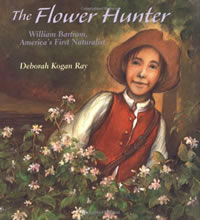 “My father, John Bartram, is a botanist. He studies plants and trees. I help him with his work. My name is William, but everyone calls me Billy. Father calls me his ‘little botanist.'”
“My father, John Bartram, is a botanist. He studies plants and trees. I help him with his work. My name is William, but everyone calls me Billy. Father calls me his ‘little botanist.'”
Thus Deborah Kogan Ray begins her first person narrative of the life of William Bartram (1739-1823) in “The Flower Hunter,” a book written for children that can be read with enjoyment by adults as well. Much has been written about this early American naturalist and artist — and his equally famous botanist father, John Bartram (1699-1777) — but none can match the charm of this 40-page book, which is richly illustrated by the author.
“The Flower Hunter” tells the story of a young boy who grows up on a farm near Philadelphia and early becomes fascinated by his father’s love of plants and botanical exploration. Throughout his childhood, Billy’s father leads him on field trips that range farther and farther away from the farm. Eventually their roles reverse, and the son becomes an explorer who returns home triumphantly to share his discoveries about the natural world with his aging father.
Kogan Ray places her straightforward account against a wider backdrop — the struggles of an emerging nation and the hardships and thrills of travel through a landscape and time very different from today. New plants, animals and even peoples are waiting to be found, described and – unusual for scientific traditions of the time — cherished in their natural state.
Why do the Bartrams remain important to us now? Together they discovered the Franklin tree (Franklinia alatamaha) in coastal Georgia in 1765; a short time later the tree became extinct in the wild. An example of this beautiful tree, that blooms in autumn while its foliage is turning bright red, can be found on the east edge of the Arboretum’s Azalea Way, about 100 yards north of the Winter Garden.
While today’s botanic gardens and arboreta would be duller places without the Franklin tree, the Bartrams left us far more than this one showstopper. Their farm became one of the first botanic gardens in the United States, and is open to the public. (see “Bartram’s Garden website). And they were instrumental, along with their friend Benjamin Franklin and others, in developing an American tradition of studying the natural sciences.
Perhaps best, they both wrote detailed journals of their travels. William’s “Travels,” published in 1791, is still in print today and is credited by Kogan Ray with having “inspired Henry David Thoreau and Charles Darwin with its observations of the world of nature.”
Excerpted from the Summer 2008 Arboretum Bulletin.
 Steve Whysall has been a regular garden writer for the Vancouver Sun for 15 years. “Best Plant Picks” selects trees, shrubs, perennials, bulbs, and ferns from his more recent columns and organizes them in a gardening calendar, including tips on monthly chores and seasonal highlights. While not a major departure for the author’s earlier books, there are some interesting juxtapositions here. A good choice for a new gardener who is willing to experiment.
Steve Whysall has been a regular garden writer for the Vancouver Sun for 15 years. “Best Plant Picks” selects trees, shrubs, perennials, bulbs, and ferns from his more recent columns and organizes them in a gardening calendar, including tips on monthly chores and seasonal highlights. While not a major departure for the author’s earlier books, there are some interesting juxtapositions here. A good choice for a new gardener who is willing to experiment. Ann Lovejoy has updated her popular 2004 “Handbook of Northwest Gardening,” with a new appendix entitled “What’s New in Sustainable Gardening.” Here she discusses rain gardens (that capture as much of naturally occurring water as possible), dry gardens (plantings that survive and even thrive with no supplemental watering once established), and the importance of bees and their current peril — and ways that gardeners can help their cause. All good additions.
Ann Lovejoy has updated her popular 2004 “Handbook of Northwest Gardening,” with a new appendix entitled “What’s New in Sustainable Gardening.” Here she discusses rain gardens (that capture as much of naturally occurring water as possible), dry gardens (plantings that survive and even thrive with no supplemental watering once established), and the importance of bees and their current peril — and ways that gardeners can help their cause. All good additions.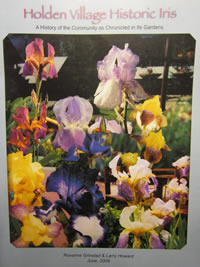 One of the most unique books in the Elisabeth C. Miller Library collections is “Holden Village Historic Iris,” the accounting of the surviving garden iris from the village of a mining camp that operated near the upper end of Lake Chelan from 1937 – 1957. Now established at a nearby Lutheran ministry known as Holden Village, these irises are a living history. Grown by the wives of the miners, many survived untended for more than 40 years in abandoned gardens.
One of the most unique books in the Elisabeth C. Miller Library collections is “Holden Village Historic Iris,” the accounting of the surviving garden iris from the village of a mining camp that operated near the upper end of Lake Chelan from 1937 – 1957. Now established at a nearby Lutheran ministry known as Holden Village, these irises are a living history. Grown by the wives of the miners, many survived untended for more than 40 years in abandoned gardens. “My father, John Bartram, is a botanist. He studies plants and trees. I help him with his work. My name is William, but everyone calls me Billy. Father calls me his ‘little botanist.'”
“My father, John Bartram, is a botanist. He studies plants and trees. I help him with his work. My name is William, but everyone calls me Billy. Father calls me his ‘little botanist.'” Children’s books may lead to some interesting discoveries in adult literature. The story of Billy, the little botanist, grows up in “The Art and Science of William Bartram” by Judith Magee. Here the simple leaf-drawing boy is revealed as more than an intrepid explorer and skilled artist of nature.
Children’s books may lead to some interesting discoveries in adult literature. The story of Billy, the little botanist, grows up in “The Art and Science of William Bartram” by Judith Magee. Here the simple leaf-drawing boy is revealed as more than an intrepid explorer and skilled artist of nature.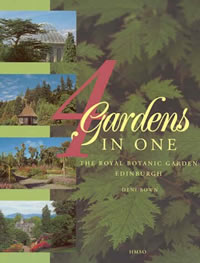 “4 Gardens in One,” by Deni Bown is an excellent source for learning about the four sites of the Royal Botanic Gardens Edinburgh. Written with passion and an eye for lively history — Bown took the photographs, too — in her details about the Younger Botanic Garden at Benmore, I learned the full truth of Rhododendron ponticum. “Even today one will encounter areas in the far west of the garden which are yet to be cleared; these are still ponticum territory and virtually impenetrable.”
“4 Gardens in One,” by Deni Bown is an excellent source for learning about the four sites of the Royal Botanic Gardens Edinburgh. Written with passion and an eye for lively history — Bown took the photographs, too — in her details about the Younger Botanic Garden at Benmore, I learned the full truth of Rhododendron ponticum. “Even today one will encounter areas in the far west of the garden which are yet to be cleared; these are still ponticum territory and virtually impenetrable.”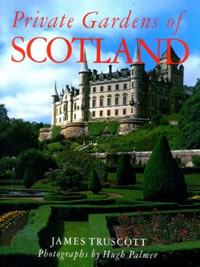 James Truscott states in the introduction to Private Gardens of Scotland his hope to transport the reader to “…a temporary withdrawal from humdrum everyday life into a cloistered world of scents and colours, where half-forgotten feelings of wonderment and awe can be rediscovered.” An ambitious goal, but he succeeds by having one of the best pens for garden description I’ve ever read. The photographs of Hugh Palmer compliment the writing, but they are not the stars. This book is meant to be read — even if you never visit the gardens, Truscott’s nuance of detail and narrative style of “touring” will teach you much, especially about design, as is befitting for an author who is also a landscape architect. He’s full of fun facts, too: Did you know that Mary Queen of Scots, the Crown Prince of Imperial Japan, and Margaret Thatcher have all planted trees at Scone Palace near Perth?
James Truscott states in the introduction to Private Gardens of Scotland his hope to transport the reader to “…a temporary withdrawal from humdrum everyday life into a cloistered world of scents and colours, where half-forgotten feelings of wonderment and awe can be rediscovered.” An ambitious goal, but he succeeds by having one of the best pens for garden description I’ve ever read. The photographs of Hugh Palmer compliment the writing, but they are not the stars. This book is meant to be read — even if you never visit the gardens, Truscott’s nuance of detail and narrative style of “touring” will teach you much, especially about design, as is befitting for an author who is also a landscape architect. He’s full of fun facts, too: Did you know that Mary Queen of Scots, the Crown Prince of Imperial Japan, and Margaret Thatcher have all planted trees at Scone Palace near Perth?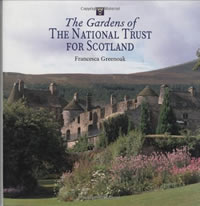 How I wish “The Gardens of The National Trust for Scotland,” by Francesca Greenoak had been available when I visited Scotland gardens, as nearly every garden on my short list was part of the Trust. I would have known before my visit that Inverewe is indeed a rhododendron haven with over 2,000 different types, and that the founder was known as “bigleaf” Osgood for his love of large-leaf rhodies. Greenoak is skilled at teasing out these life-giving facts for her garden descriptions. Of equal importance are the photographs of Brian Chapple. Much more than coffee table filler, his images tell a story, such as the rejuvenation of the massive and ancient yew hedges at Crathes Castle. I gasped at seeing stately walls of green cut back to bare stumps, but subsequent images show the gradual regrowth and restoration of these 300 years old masterpieces. The gardening staff knows their craft!
How I wish “The Gardens of The National Trust for Scotland,” by Francesca Greenoak had been available when I visited Scotland gardens, as nearly every garden on my short list was part of the Trust. I would have known before my visit that Inverewe is indeed a rhododendron haven with over 2,000 different types, and that the founder was known as “bigleaf” Osgood for his love of large-leaf rhodies. Greenoak is skilled at teasing out these life-giving facts for her garden descriptions. Of equal importance are the photographs of Brian Chapple. Much more than coffee table filler, his images tell a story, such as the rejuvenation of the massive and ancient yew hedges at Crathes Castle. I gasped at seeing stately walls of green cut back to bare stumps, but subsequent images show the gradual regrowth and restoration of these 300 years old masterpieces. The gardening staff knows their craft! For something to fit in your suitcase when travelling to Scotland, consider “Scottish Wild Plants: Their History, Ecology and Conservation.” Authors Philip Lusby and Jenny Wright skillfully weave into some 40 plant profiles description, habitat, ecological niche, associated plants and animals, natural history, and even something of the history of Scottish botany. This is good reading straight through, yet still useful as a reference work, although you’ll want a pocket field guide, too — there are several good ones in any Scottish bookstore. This book is more for setting the mood. For example, you’ll learn that Primula scotica is one of the few endemic plants in Scotland and its survival is linked to rabbits, an introduced animal to Britain in Roman times. But the relationship isn’t what you’d guess. The Scottish primrose actually thrives best where rabbits are plentiful, as they eat the plants that shade this tiny, post-glacial relic.
For something to fit in your suitcase when travelling to Scotland, consider “Scottish Wild Plants: Their History, Ecology and Conservation.” Authors Philip Lusby and Jenny Wright skillfully weave into some 40 plant profiles description, habitat, ecological niche, associated plants and animals, natural history, and even something of the history of Scottish botany. This is good reading straight through, yet still useful as a reference work, although you’ll want a pocket field guide, too — there are several good ones in any Scottish bookstore. This book is more for setting the mood. For example, you’ll learn that Primula scotica is one of the few endemic plants in Scotland and its survival is linked to rabbits, an introduced animal to Britain in Roman times. But the relationship isn’t what you’d guess. The Scottish primrose actually thrives best where rabbits are plentiful, as they eat the plants that shade this tiny, post-glacial relic.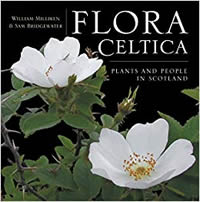 If I could only have one book on Scottish plants, it would be “Flora Celtica: Plants and People in Scotland.” While the main title suggests a comprehensive, taxonomic review of natives, authors William Milliken and Sam Bridgewater instead use ethnobotany as their framework to categorize plants by their impact on humans.
If I could only have one book on Scottish plants, it would be “Flora Celtica: Plants and People in Scotland.” While the main title suggests a comprehensive, taxonomic review of natives, authors William Milliken and Sam Bridgewater instead use ethnobotany as their framework to categorize plants by their impact on humans.